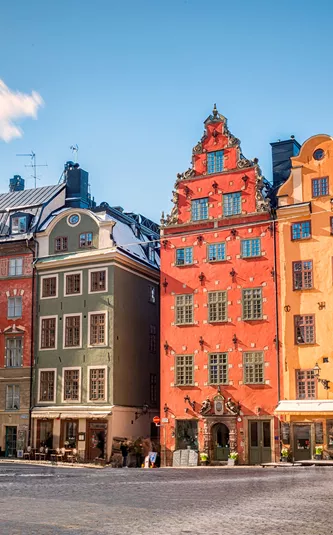© Adventure World 2024. All Rights Reserved.
MAKE TRAVEL MATTER® is a trademark of The TreadRight Foundation, registered in the U.S. and other countries and regions, and is being used under license.
Travel tips
Spring
Mar-May
avg. temp:
6˚C / 43˚F
Summer
Jun-Aug
avg. temp:
17˚C / 63˚F
Autumn
Sep-Nov
avg. temp:
6˚C / 43˚F
Winter
Dec-Feb
avg. temp:
0˚C / 32˚F
Country dialing code
+46
Capital city
Stockholm
Official language
Swedish
Currency
Krona
When to visit: Sweden generally enjoys a temperate climate, with year-round snow and short summers in the far north above the Arctic Circle, and short and cold winters and moderate summers in central and southern Sweden. Winter in Sweden lasts from November to February, when temperatures drop, and winds pick up in coastal areas and along the shores. Warm, weatherproof clothing is recommended when travelling during winter, particularly in the northern regions. Winter is the perfect time to experience a winter wonderland and to revel in the spectacle of the northern lights or Aurora Borealis. This phenomenon can generally be seen from the beginning of September in and around Kiruna in the far north of Sweden, and by the time winter has descended in January also throughout Swedish Lapland. The last glimpses of the natural phenomenon can be seen as late as the end of March or early April at times, weather conditions permitting. Beginning in March and lasting until May, the weather conditions in spring can be quite unpredictable, so it is best to be prepared for the changeable conditions. Landscapes begin to bloom with flowers during the spring, and visitors can enjoy good weather with fewer crowds. Summer in Sweden is the best, but busiest time to visit, with warmer weather offering visitors the chance to visit beautiful beaches, go hiking or head north to experience the Midnight Sun. The autumn months of September and October bring similar weather conditions to spring.
Highlights
Lapland’s wilderness, forest and tundra regions in search of Sweden’s ‘Big Six: moose, wolverines, wolves, brown bears, lynxes and musk oxen.
Sleep in an igloo or hotel made of ice and see the northern lights – brave the crisp winter nights to witness one of nature’s most spectacular displays – the Aurora Borealis. And what better way to see the dancing night sky, than from the comfort of your own glass-domed room or even a hotel constructed from ice blocks.
Embrace your Fika – Swedish cuisine is much more than just meatballs. From the selection of delicious toppings adorning open sandwiches or smörgås, to making time for a coffee and cake break or fika, Swede’s enjoy celebrations which centre around the sharing of food.
Sámi cultural traditions – The indigenous Sámi people who live in the northern part of Scandinavia have called this region home for thousands of years, and their rich and ancient traditions are still part of the way of life in the Arctic region.
Useful information
Your search for ""
clear searchCommunications
Country code for Sweden is: +46.
Emergency services: Ambulance 112, Fire: 112, Police 112
Customs
Many Swedish customs are closely linked to the change of the season, with summer celebrated through traditional festivals, local foods and seasonal delicacies and the long, dark winter gives way to a celebration of summer’s longer, milder days. Midsummer festivities tend to take place outdoors, street parties and festivals taking place in mid-June, following Sweden’s National Day on 6 June each year. Swedes can be seen as quite reserved and polite, with society based on equality, fairness and order in day to day life. Nature, the environment and outdoors are important in Sweden, and the country in general is very green, with less than one percent of household waste ending up in landfill in Sweden. Allemansrätten, or the Right of Public Access, gives all Swedes the right to enjoy the country’s outdoors, and brings with it the responsibility to treat flora and fauna with care, something which is written into the Swedish constitution.
Electricity
The electricity current in Finland is 230V, 50Hz. Sweden uses European-style two-pin plugs (Type C and F).
Getting around
Language
Swedish, with English also widely spoken.
Health
Please consult a medical practitioner or contact The Travel Doctor for your specific risk to these preventable diseases and the appropriate avoidance measures. Australians travelling to Scandinavia or the Baltics should also ensure that they have adequate travel insurance to cover the length of their stay. For further information please visit the Smartraveller website
Swedish medical facilities have similar standards to those in Australia, however emergency services can be limited in remote areas. Australia has a reciprocal healthcare agreement with Sweden. Ticks are very common in country areas from March to November, so you should exercise precautions and monitor for signs of tick bites and infection.
Tipping
Shopping
In the cities and main towns, larger shopping malls are open during the following hours:
Monday – Friday 9:30am – 6:00pm
Saturday 9:30am – 2:00pm or 4:00pm
Some shops are also open on Sundays from 12:00pm – 4:00pm. Hours may vary in smaller towns and local shops in the countryside.
Sweden is renowned for its high-quality glass and crystal including brands such as Orrefors and Kosta Boda, as well as the clean and contemporary design style which influences Swedish fashion, homewares and jewellery. You can also find uniquely Swedish foods such as Lingonberry Jam, or Saltlakrits, which is a popular salted liquorice with a very acquired taste.
Visas
The Travel Corporation has partnered with the company Sherpa to provide travellers with the latest government and health restrictions. Simply enter the country you want to travel to for information on safety regulations, border closures, quarantine requirements, your travel visa and more using the Sherpa travel tool.
FIND OUT WHAT YOU NEED TO KNOW FOR YOUR TRIP
Official travel advice is available by visiting the SmartTraveller Website








